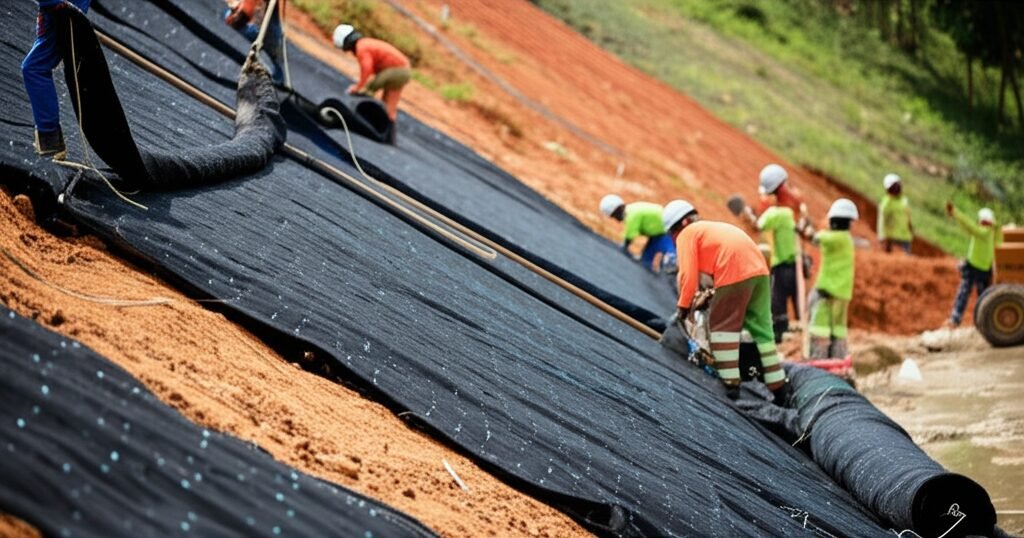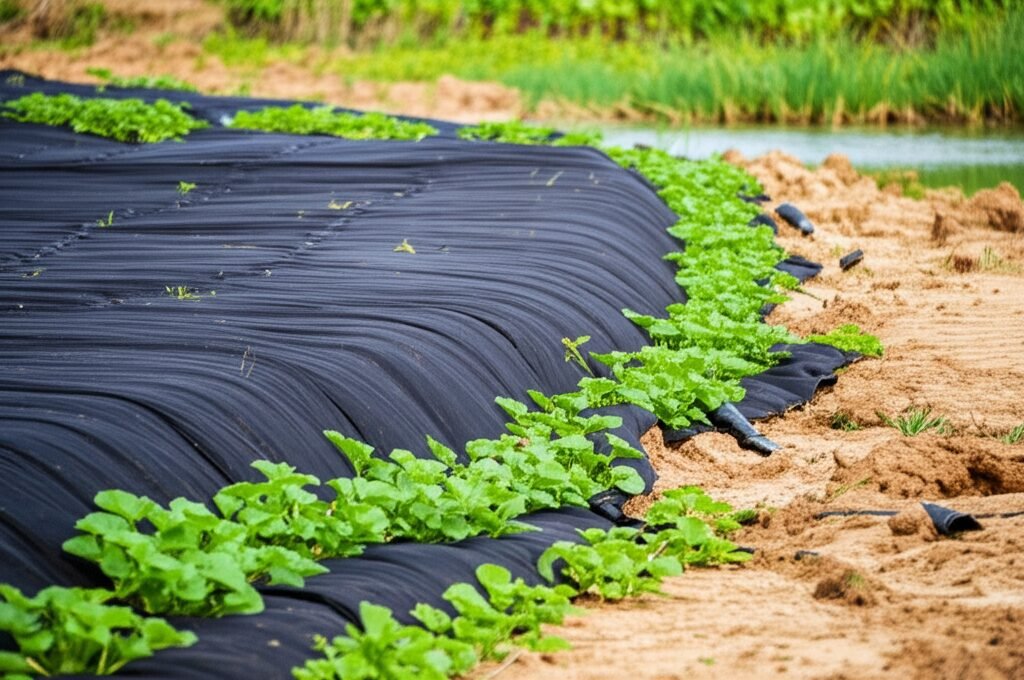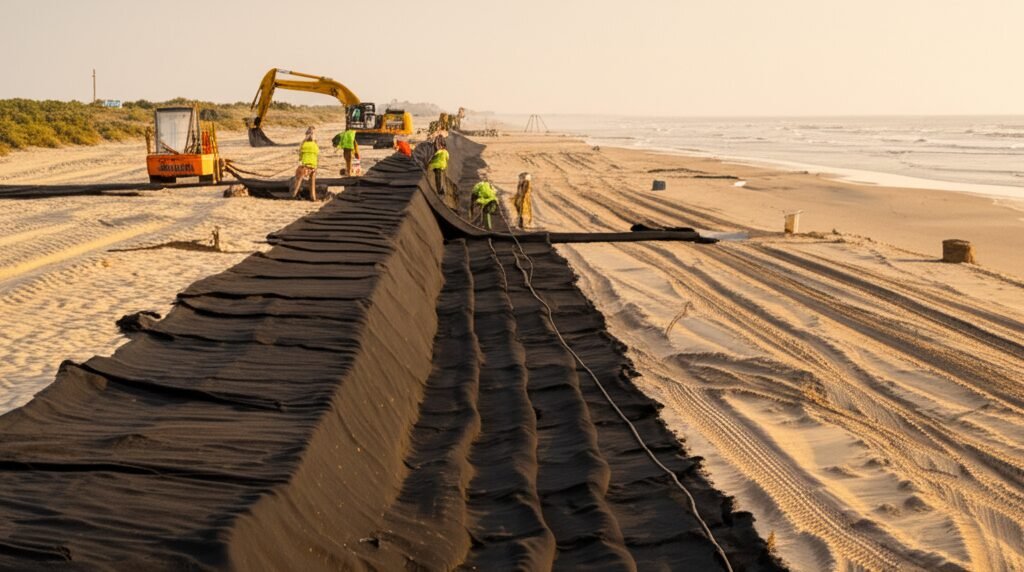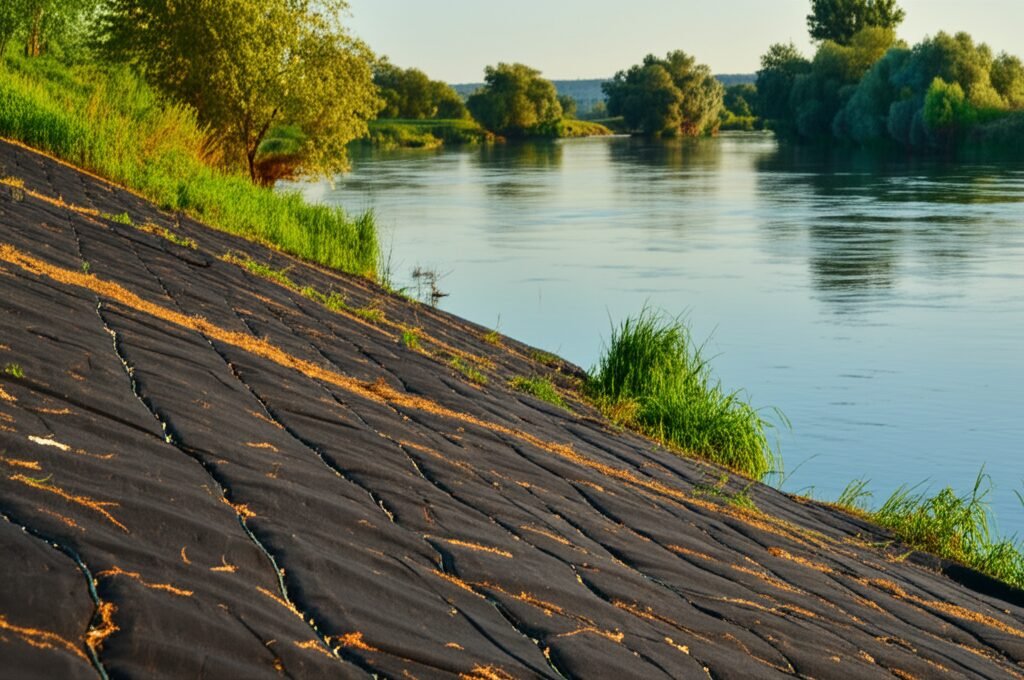Geotextile Scour Protection for Bridge Pier Erosion Control
Key Takeaways:
- Bridge pier scour is the erosion of soil around bridge supports caused by flowing water. It’s a major threat to bridge safety.
- Geotextile mattresses are double-layered fabric forms filled with concrete or grout.
- They create a flexible, permeable armor layer that protects the riverbed from erosion.
- Key advantages include adaptability to contours, reduced turbulence, and effective filtration.
- Proper installation around the pier base is crucial for effectiveness.
- Compared to traditional methods like riprap, they often offer better long-term performance and lower maintenance.
- Different types exist, like standard and raised-pattern, offering options for cost and material efficiency.
Understanding Bridge Pier Scour: Why It’s a Big Deal
So, what happens when water flows past a bridge pier? Seems simple enough, right? But the water doesn’t just glide by; it speeds up and swirls around the base of that pier. This faster, turbulent water starts digging away at the riverbed or seabed material – sand, silt, gravel, whatever’s down there. That digging action is what we call scour. And lemme tell ya, it’s a bigger deal than most folks realize for bridge safety. It basically undermines the foundation of the bridge support. If enough material gets washed away, the pier can become unstable, tilt, or in the absolute worst case, lead to a bridge collapse. We’ve seen it happen, unfortunately. Preventing this kinda erosion, this scour, is super important for keeping our bridges standing strong and safe for everyone using ’em.
Think about the forces involved. You got constant water flow, and during floods or heavy rain, that flow becomes much more powerful. The shape of the pier itself influences how the water moves around it, creating complex vortexes that are really good at lifting and carrying away sediment. Over time, even slow erosion can create a significant scour hole around the pier base. I remember working on one bridge inspection years ago, seemed fine from the surface, but the dive team found scour holes deep enough to almost swallow a small car. Scary stuff. That’s why Specialized Geotextile Protection for Critical Infrastructure is so critical. You can’t just build a bridge and hope for the best; you gotta actively protect its foundations from the get-go, or at least implement protection when you realize there’s a problem brewing. Ignoring scour is like ignoring a leaky roof – it only gets worse and more expensive to fix later.
The traditional way to fight scour was often just dumping big rocks, called riprap, around the pier. And yeah, sometimes that works, for a bit. But riprap has its own problems. The rocks can get washed away in really strong currents, especially if they aren’t sized or placed just right. Water can still find ways to scour underneath or between the rocks. Plus, big angular rocks can actually sometimes increase turbulence downstream, potentially causing issues elsewhere. Finding effective, long-lasting solutions led engineers to look at other materials, and that’s where things like Transform Terrains with Durable Geotextile Mattresses come into the picture. These offer a more engineered, reliable approach compared to just piling up stones and hoping they stay put. The consequences of failure are just too high to rely on guesswork. You need something designed specifically for the hydraulic forces at play.
What Exactly Are Geotextile Mattresses?
Alright, so we know scour is bad news bears for bridges. What’s this geotextile mattress thing then? Picture this: it’s basically like a big, tough fabric quilt, but instead of fluffy batting inside, it’s designed to be filled with concrete or grout. You got two layers of specially engineered geotextile fabric stitched together in a specific pattern. This pattern creates compartments or pockets within the mattress. When you pump the grout or concrete mix in, it fills these pockets, forming a solid but still somewhat flexible slab that conforms to the shape of the riverbed or seabed around the pier. It’s kinda clever, really. You get the strength and weight of concrete, but delivered in a way that’s adaptable and easier to install, especially underwater, compared to pouring massive amounts of loose concrete or placing individual blocks perfectly.
These aren’t just any old bits of cloth, mind you. The geotextile fabric itself is key. It’s gotta be strong enough to handle the pressure of the grout being pumped in, durable enough to last for decades in harsh underwater environments (think abrasion, UV exposure if near the surface, chemical resistance), and, crucially, it needs to have the right filtration properties. We’ll get more into the filtration bit later, ‘cos it’s super important. The basic idea though is you lay this empty ‘quilt’ down where you need the protection, usually around the base of the bridge pier, extending outwards, and then you fill ‘er up. The result is a continuous, protective layer that armors the soil beneath it, stopping the water from eroding it away. You can find out more about the basics in this Geotextile Mattress Uses, Benefits & Installation Guide. It gives a good overview of how these systems are put together and why they’re effective.
The manufacturing process, led by experts like Li Gang: Expert Geotextile Mattress Manufacturing Leader, ensures these mattresses meet strict quality standards. The stitching patterns, the fabric specifications, the fill ports – everything is designed for optimal performance. Different patterns exist too, some are flat, others have raised profiles which can save on concrete volume while still providing excellent erosion resistance. It’s not just a bag you fill; it’s an engineered system designed to create a specific type of protective structure once filled. The flexibility before filling makes them easier to transport and deploy compared to precast concrete elements, and their ability to conform closely to the existing ground surface minimizes undermining potential. It’s a really practical solution for a tricky problem.
Why Use Geotextile Mattresses for Bridge Scour Protection?
So why pick these mattresses over, say, just dumping more rocks (riprap)? Well, there’s a bunch of good reasons, based on what I’ve seen out in the field. First big one is flexibility and conformity. Unlike rigid concrete slabs or even loose riprap which can leave gaps, a geotextile mattress, when filled, settles right onto the contours of the riverbed. This snug fit is huge because it makes it way harder for water to get underneath and start scouring again. Riprap, especially if not properly graded or placed, can have voids where erosion can still get a foothold. I worked on a project replacing failed riprap around a pier; the rocks had shifted, created gaps, and the scour just kept gnawing away underneath. Slapping down a mattress fixed it proper, molding right into the existing scour profile.
Another key advantage is hydraulic performance. Big, chunky rocks can sometimes make turbulence worse locally. Geotextile mattresses, especially the standard flatter types, present a smoother, more uniform surface to the flow. This generally means less turbulence right at the bed level compared to riprap, which further reduces the erosive forces acting on the protected area and just downstream. They also have controlled permeability. The fabric lets water seep through slowly, relieving hydrostatic pressure from underneath, but it holds back the soil particles. Riprap can sometimes get clogged with fines, or conversely, allow too much flow through the larger voids, potentially washing out the base material it’s supposed to protect. This is a major plus discussed often when looking at the Advantages and Applications of Geotextile Mattresses in Erosion Control.
They are also surprisingly durable and low maintenance. Once the concrete or grout cures, you’ve got a tough, monolithic slab that resists abrasion and displacement pretty darn well. Unlike riprap that might need topping up or repositioning after major floods, a well-installed mattress generally just sits there doing its job for decades. Sure, you still need inspections, but repairs are less frequent. Installation can often be quicker and sometimes safer too, especially in deep water or difficult access situations, compared to bringing in tons and tons of specific-sized rock and placing it accurately with heavy machinery. We’ve seen some great examples on various Proven Geotextile Mattress Projects for Water Infrastructure that show just how resilient these systems are in real-world conditions, protecting vital bridge assets. It’s about providing reliable, long-term protection rather than a temporary fix.
The Role of Filtration in Geotextile Mattress Systems
Okay, let’s talk filtration. This is maybe the most technical bit, but it’s absolutely vital to why these mattresses work so well, ‘specially compared to just solid concrete or less permeable options. Remember how I said the fabric lets water through but keeps soil back? That’s the filtration job. Think about it: groundwater or water pressure from the river itself can build up under any kind of armouring layer. If that pressure can’t escape, it can try to lift the protection up, or worse, it can cause the fine soil particles from underneath to get slowly washed out through any gaps or joints. This internal erosion, called piping, can undermine the whole system from below even if the top surface looks fine. That’s bad!
The geotextile fabric used in these mattresses is specifically designed with an Apparent Opening Size (AOS) and permeability that matches the type of soil it’s being placed on. The AOS relates to the size of the pores in the fabric – small enough to stop the important soil particles from escaping, but large enough to let water pass through relatively easily. The permeability, measured usually as flow rate, needs to be high enough to prevent that pesky pore water pressure from building up to dangerous levels. It’s a balancing act. You need Advanced Filtration Geotextile Mattress Systems that are tailored to the site conditions. Using the wrong fabric for the soil type could either lead to clogging (if pores are too small) or excessive soil loss (if pores are too big).
This filtration function is something that traditional riprap often struggles with, unless you install a separate geotextile filter layer underneath it correctly, which adds complexity and cost. With the mattress, the filter fabric is an integral part of the system. It ensures that the soil directly beneath the concrete-filled structure stays put, maintaining the foundation’s integrity. I recall one early project where an impermeable liner was used mistakenly instead of a proper filter geotextile under a different type of revetment – pressure built up during a flood event and caused a section to literally float and break apart. That lesson stuck with me: you absolutely need that pressure relief mechanism provided by a correctly specified filter fabric. It’s not just about stopping surface erosion; it’s about ensuring stability from below too. Managing water flow and pressure is just as important as providing physical armour, something emphasized in broader contexts like Stormwater Quality Management.
Choosing the Right Type: Standard vs. Raised-Pattern Mattresses
Now, not all geotextile mattresses look the same once they’re filled. There’s generally two main flavours you’ll run into: the standard, relatively flat ones, and the ones with a raised pattern, sometimes called filter point mattresses. The standard ones give you a more or less uniform thickness of concrete or grout across the whole area. They provide a really solid, heavy armour layer, great for high-flow situations where you need maximum weight and resistance. They look kinda like a concrete slab, but remember, they were flexible during installation and have that all-important filter fabric base.
Then you got the Raised-Pattern Geotextile Mattress Systems Cut Costs 40%. These are pretty neat. The stitching pattern creates thicker sections (the ‘raised’ bits) connected by thinner areas where the two fabric layers are stitched closer together. When you fill it, the concrete mostly goes into these thicker pockets. The thinner ‘filter point’ areas don’t fill completely, or fill much less, leaving fabric-against-fabric spots. What’s the point? Well, a couple things. First, it uses significantly less concrete or grout to cover the same area compared to a standard mattress of the same maximum thickness. Less concrete means lower material costs, less weight to transport and handle, and potentially faster pumping times. That 40% cost saving claim isn’t just marketing fluff; on big projects, the volume difference really adds up. I worked on a channel lining job where switching to a raised-pattern design saved the client a substantial amount on grout alone.
So when do you use which? Standard mattresses are often the go-to for really severe conditions around bridge piers where you need that brute weight and maximum possible thickness for impact resistance (like from large debris). The raised-pattern ones are fantastic where conditions are still tough but maybe not quite as extreme, or where cost savings are a major driver. Those filter points also enhance the flexibility of the cured mattress slightly and dramatically increase the surface area available for pressure relief and drainage through the fabric, which can be beneficial in certain soil conditions. They can also provide better habitat nooks for wee aquatic critters compared to a smooth slab, if that’s a consideration. The choice often comes down to a site-specific engineering assessment, weighing the hydraulic forces, the foundation soils, budget constraints, and the specific goals for the Specialized Geotextile Protection for Critical Infrastructure being installed. Both types are effective, but optimizing the selection can make a big difference to the project’s bottom line and long-term success.
Installation Process Around Bridge Piers: What to Expect
Putting these mattresses down, especially around an existing bridge pier in flowing water, takes some know-how. It ain’t just chucking it in the river. First step is always site preparation. This means clearing any debris, loose rocks, or significant vegetation from the area where the mattress will sit. Sometimes you need to do some grading or excavation to get the right profile, especially if there’s already a big scour hole you need to fill or shape before placing the mattress. You want a reasonably smooth surface for the mattress to lay on properly. For underwater work, this usually involves divers or specialized equipment.
Next comes the mattress placement. The large fabric panels are carefully positioned around the base of the pier. This often involves cranes, barges, or sometimes divers again to guide the mattress into its final spot. You gotta make sure it covers the required area, overlaps correctly if you’re using multiple panels, and sits snugly against the pier itself. Securing the edges is important too, often by trenching them in or using anchor pins, to prevent undermining starting at the perimeter. Once it’s in place, you connect the filling hoses to the inlet ports built into the mattress.
Then comes the filling process. A specific concrete or grout mix – usually fine aggregate concrete or a sand-cement grout – is pumped into the mattress. This has to be done carefully, controlling the pressure and flow rate. You fill it strategically, often from the lowest point upwards if there’s a slope, to ensure all the compartments fill evenly and air gets pushed out through designated vent ports or the fabric itself. Quality control here is key. You need to monitor the filling to make sure you achieve the desired thickness and don’t over-pressurize and burst the fabric seams (though they are pretty strong!). Experienced installers know how to manage the pump and monitor the mattress inflation. Finally, once it’s full, the concrete/grout needs time to cure and harden, forming the solid protective layer. The time depends on the mix and water temperature. Many Proven Geotextile Mattress Projects for Water Infrastructure showcase successful installations even in challenging river or coastal environments, demonstrating it’s a very feasible process with the right team and equipment.
Long-Term Performance and Maintenance Considerations
One of the big questions engineers and asset owners always ask is: how long will this stuff last? And what do I need to do to keep it working? That’s fair enough, you want value for money and reliable protection. Generally speaking, geotextile mattresses, when properly designed and installed, offer excellent long-term performance. We’re talking decades of service life. The concrete or grout fill provides the primary armouring, and high-quality concrete is obviously very durable. The geotextile casing itself, while critical for installation and filtration, is somewhat protected by the concrete fill once cured, especially on the top surface. The fabrics used are typically polyethylene or polypropylene, which are highly resistant to rot, chemicals found in typical water bodies, and biological degradation.
Compared to riprap, which as we discussed can shift, degrade (some rock types break down over time), or get undermined, the mattress tends to be more stable and consistent. Because it forms a continuous, interlocked (by the fill) structure, it’s much less prone to individual elements being plucked out by high flows. Its flexibility allows it to accommodate minor settlement of the underlying soil without cracking like a rigid slab might. Of course, nothing is invincible. Extreme events, like massive floods carrying huge debris (think tree trunks or ice floes), could potentially damage the surface. That’s why periodic inspections are still necessary, just like for any critical infrastructure. This usually involves visual checks (above water) and often underwater inspections by divers or remote cameras, maybe every few years or after major flood events, to look for any signs of abrasion, cracking, or undermining at the edges.
Maintenance is usually minimal though. If minor damage is found, repairs are often possible. Small cracks or spalls in the concrete might be patched. If a section somehow gets seriously damaged, it might be possible to cut out the damaged area and install a new mattress section, or overlay it. But generally, they’re considered a low-maintenance solution. When you need Expert Geotextile Mattress Solutions for Erosion Control, you’re usually looking for that initial design and installation expertise, knowing that the ongoing upkeep should be manageable. Having reliable manufacturing, like that overseen by folks like Li Gang: Expert Geotextile Mattress Manufacturing Leader, also contributes to that long-term confidence in the product’s durability right from the start. Overall, the longevity and low upkeep are major selling points for using mattresses in scour protection.
Thinking Beyond Piers: Other Applications and Innovations
While we’ve focused on protecting bridge piers cause that’s a super common and critical need, these geotextile mattresses are actually pretty versatile bits of kit. They aren’t just a one-trick pony. Anywhere you need to stop soil erosion caused by water, they are likely a potential solution. Think about shoreline protection along coasts, lakes, or reservoirs. They can armour banks against wave action, preventing valuable land from washing away. Same goes for riverbanks and channel linings. Instead of hard-engineering with concrete walls, mattresses can provide a stable lining that prevents bank erosion during high flows, often conforming better to natural shapes and sometimes allowing for vegetation growth in certain types.
We’re also seeing some interesting variations and innovations. For instance, there are Advanced Vegetation Geotextile Mattress Systems for Slope Stability. These are designed not just to armour the slope but also to incorporate soil and allow vegetation to grow right through the mattress structure. This gives you the immediate erosion protection of the mattress, plus the long-term binding and aesthetic benefits of plant roots and cover. It’s a greener approach for slopes that aren’t subject to constant high-velocity flows. Other uses include pipeline cover and protection, lining for containment ponds, spillways for small dams, and even boat ramp construction. Basically, if water’s trying to move dirt where you don’t want it to, a mattress might be the answer.
The field keeps evolving too. Research bodies and initiatives like the one looking into Smart Scour Countermeasures are constantly evaluating existing methods and exploring new technologies, potentially incorporating sensors or improved materials. Companies specializing in Erosion and Scour Solutions for Bridge Piers and other applications are always refining installation techniques and mattress designs based on field experience and research findings, like those discussed in NCHRP reports (e.g., NCHRP Report 593 might touch on related infrastructure protection). Even studies on broader environmental factors like drought conditions inform our understanding of changing water patterns that might affect scour risk. It is a dynamic area, ensuring that these tools remain effective against the ongoing challenge of erosion.
Frequently Asked Questions (FAQs)
Q1: How long do geotextile mattresses typically last when used for bridge scour protection?
A: Properly designed and installed geotextile mattresses filled with concrete or grout can last for several decades, often 50 years or more. The durability comes from the strong concrete fill and the resilient geotextile fabric casing which resists environmental degradation.
Q2: Are geotextile mattresses environmentally friendly?
A: Compared to some traditional methods, they can be considered more environmentally friendly in certain aspects. They minimize the need to quarry and transport large amounts of rock (like riprap). Some designs, like vegetating mattresses, actively support habitat creation. The contained concrete also prevents washout compared to poured-in-place alternatives. However, concrete production itself has an environmental footprint.
Q3: Can geotextile mattresses be installed in flowing water?
A: Yes, installation in flowing water is a common application. While strong currents can make placement more challenging, the flexibility of the empty mattress helps, and specialized equipment and techniques (like using dive teams or weighted guide frames) are used for accurate positioning before filling. The grout/concrete mix is typically designed to resist washout during placement.
Q4: What’s the main difference between a geotextile mattress and just using riprap?
A: A geotextile mattress forms a continuous, flexible, and permeable concrete armour layer with an integrated filter fabric. Riprap consists of loose angular stones. Mattresses generally offer better conformity to the bed, controlled filtration, potentially better hydraulic smoothness, and less risk of individual units dislodging compared to riprap, which can shift or allow undermining if not properly sized and placed with a filter layer.
Q5: How thick are these mattresses typically?
A: The thickness varies depending on the design and the hydraulic forces they need to resist. Common thicknesses range from about 4 inches (100mm) up to 12 inches (300mm) or even more for very demanding applications. Raised-pattern mattresses will have variable thickness across their surface.
Q6: Is specialist equipment needed for installation?
A: Yes, installation typically requires equipment like cranes or excavators for handling the mattress sections, concrete pumps capable of handling the specific grout/concrete mix, hoses, and potentially barges and dive support for underwater work. Experienced personnel are crucial. You can usually get help with this by contacting providers offering Expert Geotextile Mattress Solutions for Erosion Control.












